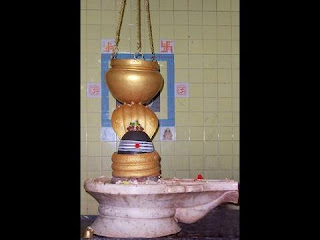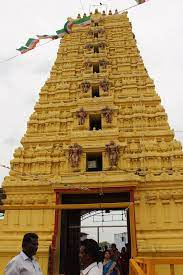This temple is located very close to Hyderabad. It is 10kms from ECIL Cross Roads and 5 kms before Keesera Gutta. It is connected to ECIL X Road by a four-lane road. Many city people visit this temple to enjoy the peaceful surroundings. The big lake before we enter the temple, with green paddy fields and trees refreshes one’s mind. The temple arch one of the biggest arches in Telengana region is very attractive with colourful carvings. On the top of the arch the idol of Sri Lakshmi Narasimha Swamy along with Lakshmi is seen flanked by idols of Ganesh and Hanuman bearing the Sanjeevani Mount. On the extreme ends two idols of Abhaya Anjaneya Swamy are seen. On the pillars of the arch the idols of Jaya and Vijaya and Garuda are seen. This is an exquisite specimen of architecture which captures the attention of the devotees.
The parking space before the temple is very
spacious and there is a place assigned for breaking coconuts. There is a shoe
stand just beside the parking place. On the way to the temple one can see
stalls selling pooja material and a hotel. The temple hall is very colourfully
painted with sculptures of various gods. Around the Pradakshina Patha
(circambulatory passage) one can see the ten incarnations of the Lord Vishnu.
The idol of Lakshminarasimha in the centre is very attractive. The idol of the
founder (Sri Mallaram Eshwaraiah) is seen in a niche. There is a tortoise-pond
behind with a beautiful statue of Lord Vishnu reclining on the serpent-bed in
the middle of the pond. Inside the sanctum the idol of Shanta Narasimha with
Lakshmi is seen under the shade of Adi Sesha.
There are many sevas done here. Every
Friday Abhishekam is performed. Swarnapushparchana is done to the main lord. In
every month on Swathi Nakshatra day, Swamy Kalyanam is done. There is a big
hall for performing various rituals Satyanarahyanavratam, Sudarshana Homa, Annaprashana
and Upanayanam. Many people make their wishes (Sankalpa) standing before Dwajha
Stambham with a coconut in their hands and go round the temple for eleven,
twenty-one or forty-one times. After their wish is fulfilled, they again come
here and go round the temple for forty-one times. Many devotees come here on
Saturday and spend the night here. The following day they do pradakshinas.
Devotees believe that their wishes would be fulfilled if they sleep five
Saturdays in this holy temple. The devotees who come here should not close
their eyes before the main deity but look at the Lord with devotion. Here the
devotees should come in traditional dress.
People wearing T-shirts and jeans are not permitted.
In 2015 the temple authorities constructed a choultry with 41 rooms with all facilities. On the days of Poornima and Amavaasya also, many devotees come here to spend the night and do pooja on the following day. So, this Lord is called “Sankalpa Siddhi Narasimha”. On every Tuesday special poojas are done to Lord Anjaneya and Lord Subrahmanaya. Kalasarpanivarana Pooja is also done on this day. On every Wednesday special poojas are done to Maha Ganapati. Special Poojas are done during the months of Kartik and Margasirsha months and on Vaikunta Ekadashi. In this temple Brahmostavams are celebrated in the month of April every year for three days.
There are many sub-shrines in this temple like, Maha Ganapati andAnjaneya. At the back of the temple near the choultry, one can see the shrines of Bangaru Mysamma, Nalla Pochamma and Subrahmanhya. These idols were found in the field of Ishwaraiah.
Regarding the founding of this
temple, the credit goes to Mallaram Eshwarayya who is a staunch devotee of Lord
Narasimha. He had a vision of Lord Narasimha who asked him to go to Yadagiri
and worship the Lord there. He went there and brought a picture of Yadagiri
Narasimha and kept it in his pooja room and lit Akhanda Deepam. Many people
visited his pooja room and worshipped the Lord. Later His son, Mallaram
Lakshminarayana too worshipped the Lord and received Narasimha mantra from
Guru. Inspired by Lord’s vision he got Narasimha idol made on April19th 2007,
and kept it in his pooja room. Later he thought a temple would be a suitable
place to worship the Lord. So, in his field guided by the Lord he selected a suitable
place and laid the foundation stone and did Pranapratishta on May 1st
2008. While digging the field, he saw a serpent as if blessing him. So, a
shrine for Naga devata is seen in the temple. The shrines of Grama Devatas
(Village goddesses), Bangaru Mysamma and Nalla Pochamma have been renovated.
In this temple the traditions followed by
Yadagiri temple priests are followed here since devotees believe that Cheeryal
Narasimha is a manifestation or Amsha of Yadagiri Lakshmi Narasimha. Many temples
of Narasimha are seen in hill-caves. But here the Lord is seen on the ground
floor and so devotees can go round the Lord to get their wishes fulfilled. Many
Telugu serials’ shooting is done here. Telengana Chief Minister, Sri K.C.R
visited this temple to fulfil his vows. The working hours of this temple are
from 6.00 a.m. to 12.30 p.m. and from 4.00 p.m. to 8.00 p.m. On Saturdays and Sundays, the working hours
are from 6.30 a.m. to 2.00 p.m. and from 4.00 p.m. to 8.00 p.m. For city people
this is a very nearby place to visit and spend peaceful time and worship the
Lord who is regarded as very powerful and who removes obstacles and fulfils
the wishes of devotees who pray to him with sincere devotion.
*********************************
29th December, 2021 Somaseshu Gutala












































